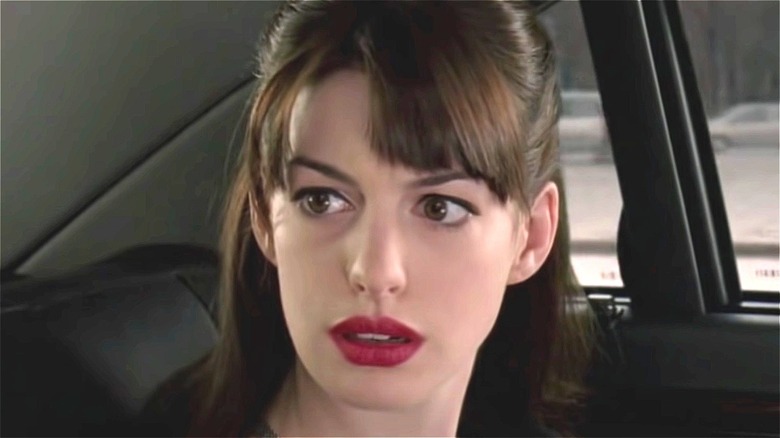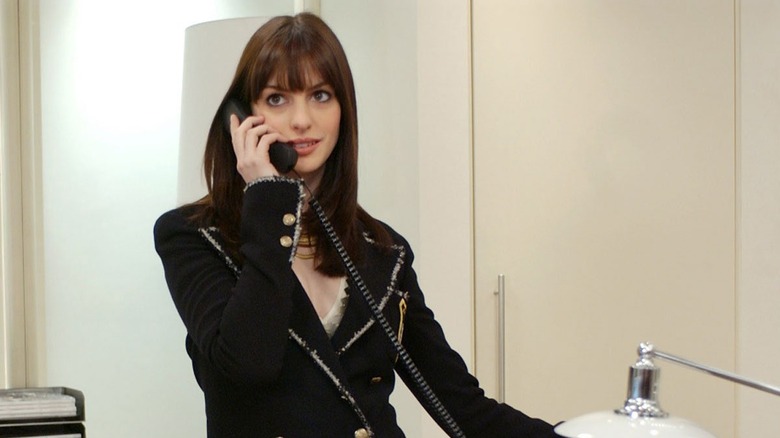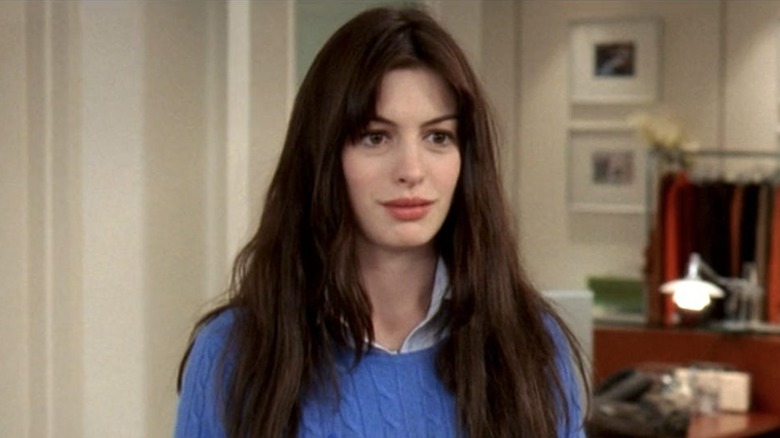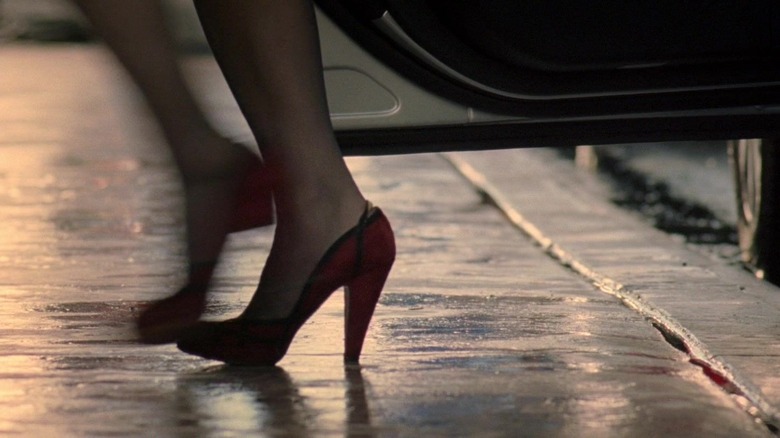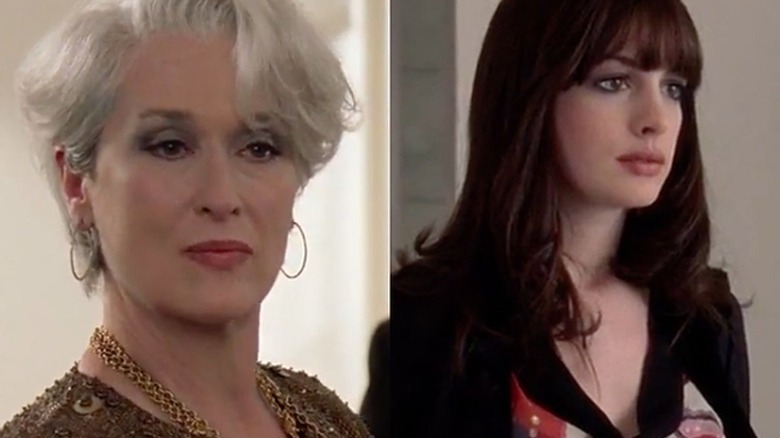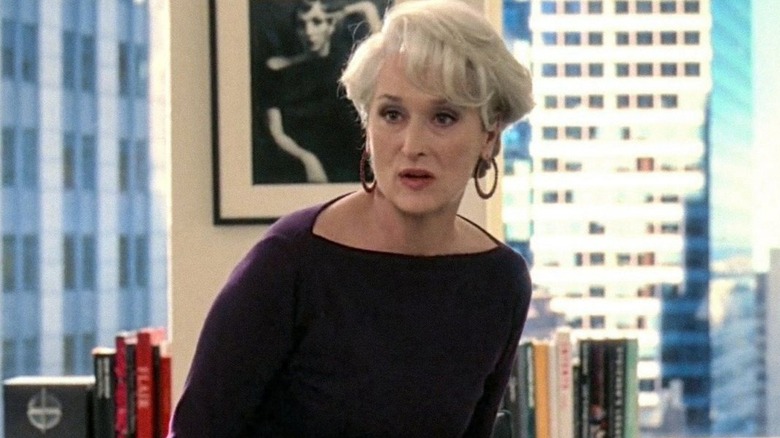The Ending Of The Devil Wears Prada Explained
In 2006, audiences were invited to watch the corporate battle between an everyday girl with journalistic dreams and a villainous (at least, upon first glance) fashion powerhouse. This is, of course, the classic "The Devil Wears Prada."
This early 2000s film stars Anne Hathaway and Meryl Steep in the lead roles, joined by the likes of Emily Blunt, Stanley Tucci, and Adrian Grenier. The story follows Andy (Hathaway), an aspiring journalist who lands herself a junior personal assistant job for Miranda Priestly (Streep), editor of Runway Magazine and queen of the fashion world. Andy has no expertise nor interest in fashion, but she takes the job for experience and as a way in. While she quickly discovers that working for Miranda is a nightmare, she decides to persevere. Soon enough, she becomes Miranda's number one personal assistant and starts developing a growing appreciation for fashion.
The movie famously ends with Andy parting ways with Miranda after Miranda does something Andy personally deems as unjust, destroying Nigel's (Tucci) career to save her own. Miranda then tells Andy that she too would have done the same, as she already did something similar to gain favor at Runway. This causes Andy to realize that she's going down the wrong path, and so she finally leaves Miranda and the fashion industry.
On the surface, this looks like a simple way to wrap up Andy's story and redeem her as a character, but looking at the bigger picture of the story, there is actually a lot of meaning in Andy's choice. Here's the ending of "The Devil Wears Prada" explained.
The evolution of fashion in The Devil Wears Prada
To better understand the ending to "The Devil Wears Prada," it's important to go over some key themes in the film. Fashion obviously plays a large role in the film since Andy works for a popular and prestigious fashion company. She is often told throughout the film that "a million girls would kill for this job." However, fashion does not just act as a background character nor a setting — it actually has importance to the overall story.
At the beginning of the film, fashion is seen through Andy's lens, making the whole concept of the fashion industry seem stupid and overrated. Andy does not see the point in Louboutin's paired with a Gucci dress: she just sees it all as pretentious, rich people things. In fact, when Andy initially interviews with Miranda, she is wearing an oversized blue sweater and a very modest skirt and seemingly everyone in the building has a thought or two about her ensemble.
As the film progresses though, Andy's view on the fashion world begins to shift. After having a talk with Nigel, where Nigel essentially tells Andy she isn't trying hard enough, Andy begins to don elevated looks and designer brands. At first, she does this to be more efficient at her job and not let Miranda get to her, but as the film continues, it becomes clear that Andy develops a genuine understanding and appreciation for the fashion world. She's able to reference designers offhand and always looks put together.
Fashion empowers Andy
Now that Andy has an appreciation for fashion, what does this mean in the bigger picture? Well, it appears once she begins to enter this world, she gains a new level of confidence and empowerment. She does her tasks with ease, she communicates with people and possible connections effortlessly, and there is a noticeable allure to her throughout the rest of the film. This is also eventually noticed by Miranda, who makes no comment, but does take a second look once seeing Andy in a couture ensemble.
Wearing designer clothes to feel empowered might sound a bit superficial at first glance, but the film is not necessarily trying to say it's the value of the clothes that matters. It is important to note that Andy is a lower-class girl using fashion as a portal to the upper class, as pointed out in a film analysis by Jonathan Clark's Uncanny Mountain. The stylish outfits Andy now wears gives her a sense of confidence which in return gets her the respect of her peers. There are a lot of places Andy goes in the film, while working for Miranda — places where she wouldn't be as respected if she were still wearing the clothes we first meet her in, at the start of the film. In fact, her chic clothing and newly found confidence leads her to meet a possible connection for her journalism career, down the road. Fashion becomes more of a tool for Andy rather than a superficial camouflage that gains her the respect of her ritzy colleagues.
Does Andy lose herself to fashion?
Over the course of the film, Andy becomes more and more wrapped up in job as Miranda basically has her on call 24/7. Due to this, Andy finds herself leaving meetups with friends early, missing her boyfriend's birthday, and cutting dinner short with her Dad all because Miranda called and Andy, without thought, answered. There is even a moment where Andy gets upset because her friends tease her and toss around her phone once Miranda starts calling.
This puts a strain on her relationships, especially with her boyfriend, who feels as if she is a different person. It also suggested that he has a similar view to the fashion world as Andy did at the beginning of the film, so he doesn't understand why she still works for Runway. So, this begs the question: Does Andy lose herself?
The short answer is not necessarily. While on the surface you could say that "The Devil Wears Prada" is a story about staying true to one's self, that's not totally the case. There are more layers to the story than that, because Andy doesn't lose herself to fashion, Runway, or Miranda — she simply evolves. She doesn't become a different person, she just adapts and opens herself up to a new world she was ignorant to before, which in turn teaches her a thing or two. The Andy at the end of the film, you could say, is the better version of Andy — one that has the same wit and determination as the film's opening Andy, but now with a chic look and the necessary tools to push herself forward.
The polarization of the new Andy
This new Andy creates a polarizing affect — both in the movie, and for viewers. Her friends and boyfriend are not big fans of Andy's new life and demeanor and aren't subtle about it. As Andy makes more strides at Runway and becomes more like Miranda, her friends grow tired of her. They don't get to see her as much, and she's constantly arriving late, even missing her boyfriend's birthday party altogether. At first, for viewers, you may want to side with the friends — as missing important events and constantly being whisked away can be quite annoying. However, upon further inspection, Andy is not exactly in the wrong, either. Andy is making important connections and learning valuable information working for Runway, as well as moving up in the chain, as Miranda promotes Andy to first assistant Emily's position, taking her to Paris Fashion Week.
She is becoming successful in her workplace and sometimes that requires sacrifice. While it can be a bit annoying for those around her, they also aren't particularly understanding of what she's gaining through Runway, since they're annoyed that she's not the same Andy they knew before.
However, there is something about the new Andy that comes as a shock to herself and viewers: When Miranda tells Andy, "I see a great deal of myself in you." Andy rejects that notion and claims she could never do what Miranda did to Nigel –- throwing him under the bus to save her job. To which Miranda reminds Andy she already has done a similar act when agreeing to come to Paris, because she had to step over Emily to do so. This is a pivotal moment in the film.
The importance of fashion
After theiseye-opening interaction with Miranda, Andy is horrified by the thought that she has become like Miranda. She doesn't want to live that way. However, Miranda famously replies, "Everybody wants to be us."
Andy ultimately decides to part ways with Miranda and Runway, ditching them both in Paris. Following this, Andy is seen in a repaired relationship with her boyfriend and interviewing for a journalism job, as she was pursuing at the beginning — but now, she's noticeably still dressed far more fashionably than before, showing how the old and new versions of Andy have merged. She spots Miranda on the street and waves, however Miranda does not acknowledge her. So, what does it all mean?
"The Devil Wears Prada" seems to be making a commentary on the importance of fashion, and while it's not afraid to poke holes, the movie's underlying themes act as a statement in fashion's defense. It does this by showing us a smart and determined girl who could care less about Louis Vuitton and Prada, and it showcases what embracing fashion did for her. It not only gave her confidence and connections, but many industry-learned skills that will help her in the long run of her journalistic endeavors. This is why Andy is still found dressing stylishly at the film's end, while she may have left behind Runway and Miranda, she has still taken what the fashion industry has taught her, and she appreciates it.
